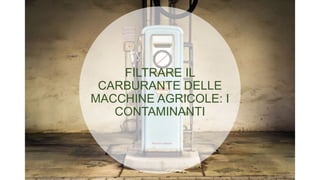Filtrare IL Carburante Delle Macchine Agricole: I Contaminanti
•Download as PPTX, PDF•
0 likes•31 views
Gli utilizzatori delle macchine agricole devono sapere come gestire il carburante per i loro macchinari. Dopo tutto, senza il carburante idoneo, le macchine agricole rischiano non solo malfunzionamenti, ma guasti importanti che comportano onerosi fermo macchina
Report
Share
Report
Share

Recommended
Recommended
More than Just Lines on a Map: Best Practices for U.S Bike Routes
This session highlights best practices and lessons learned for U.S. Bike Route System designation, as well as how and why these routes should be integrated into bicycle planning at the local and regional level.
Presenters:
Presenter: Kevin Luecke Toole Design Group
Co-Presenter: Virginia Sullivan Adventure Cycling AssociationMore than Just Lines on a Map: Best Practices for U.S Bike Routes

More than Just Lines on a Map: Best Practices for U.S Bike RoutesProject for Public Spaces & National Center for Biking and Walking
More Related Content
Featured
More than Just Lines on a Map: Best Practices for U.S Bike Routes
This session highlights best practices and lessons learned for U.S. Bike Route System designation, as well as how and why these routes should be integrated into bicycle planning at the local and regional level.
Presenters:
Presenter: Kevin Luecke Toole Design Group
Co-Presenter: Virginia Sullivan Adventure Cycling AssociationMore than Just Lines on a Map: Best Practices for U.S Bike Routes

More than Just Lines on a Map: Best Practices for U.S Bike RoutesProject for Public Spaces & National Center for Biking and Walking
Featured (20)
Content Methodology: A Best Practices Report (Webinar)

Content Methodology: A Best Practices Report (Webinar)
How to Prepare For a Successful Job Search for 2024

How to Prepare For a Successful Job Search for 2024
Social Media Marketing Trends 2024 // The Global Indie Insights

Social Media Marketing Trends 2024 // The Global Indie Insights
Trends In Paid Search: Navigating The Digital Landscape In 2024

Trends In Paid Search: Navigating The Digital Landscape In 2024
5 Public speaking tips from TED - Visualized summary

5 Public speaking tips from TED - Visualized summary
Google's Just Not That Into You: Understanding Core Updates & Search Intent

Google's Just Not That Into You: Understanding Core Updates & Search Intent
The six step guide to practical project management

The six step guide to practical project management
Beginners Guide to TikTok for Search - Rachel Pearson - We are Tilt __ Bright...

Beginners Guide to TikTok for Search - Rachel Pearson - We are Tilt __ Bright...
Unlocking the Power of ChatGPT and AI in Testing - A Real-World Look, present...

Unlocking the Power of ChatGPT and AI in Testing - A Real-World Look, present...
More than Just Lines on a Map: Best Practices for U.S Bike Routes

More than Just Lines on a Map: Best Practices for U.S Bike Routes
Ride the Storm: Navigating Through Unstable Periods / Katerina Rudko (Belka G...

Ride the Storm: Navigating Through Unstable Periods / Katerina Rudko (Belka G...
Filtrare IL Carburante Delle Macchine Agricole: I Contaminanti
- 1. FILTRARE IL CARBURANTE DELLE MACCHINE AGRICOLE: I CONTAMINANTI
- 2. Introduzione Gli utilizzatori delle macchine agricole devono sapere come gestire il carburante per i loro macchinari. Dopo tutto, senza il carburante idoneo, le macchine agricole rischiano non solo malfunzionamenti, ma guasti importanti che comportano onerosi fermo macchina. Da quali elementi bisogna proteggere il combustibile per mantenerlo in condizioni ottimali e pronto per l’uso?
- 3. #1 Acqua L'acqua nel carburante può essere di tre tipi: - acqua libera, che si separa naturalmente e si forma a causa della condensa; - acqua emulsionata, che è stata mescolata al carburante ed è causa del pompaggio o dei biocidi; - acqua disciolta, che è stata chimicamente legata al combustibile ad esempio attraverso l’uso di additivi per carburanti.
- 4. #2 Batteri I batteri tipicamente sono già nel carburante, ma non germinano senza le giuste condizioni. Queste condizioni sono: una fonte di cibo (gli idrocarburi del combustibile), la giusta temperatura / clima (qualsiasi temperatura da 10° a 40° C) e un posto dove vivere. Quel posto è il luogo di contatto fra acqua e carburante.
- 5. #3 Fango Il fango nel carburante può formarsi a causa di diversi fattori: l'accumulo di biomassa da un'infezione batterica, polvere nell'aria, derivata dalla terra o da materiali simili. Lo strato di fango in un serbatoio di carburante si trova in corrispondenza o in prossimità del fondo, e con il biodiesel questo strato si accumula molto più rapidamente.
- 6. #4 Sedimenti I sedimenti nel carburante si formano in modi diversi, ad esempio a causa della degradazione del carburante (spesso il contatto del combustibile con un materiale incompatibile, come l'ottone, dà luogo a questo fenomeno), o anche a causa dell'aggiunta di una quantità scorretta di additivi.
- 7. #5 Corpi estranei I corpi estranei nel carburante possono essere di qualsiasi tipo: dalla polvere atmosferica, al carburante di scarsa qualità, agli oggetti che inavvertitamente cadono nei serbatoi. Qualunque cosa che non dovrebbe essere nel carburante, nella migliore delle ipotesi può causare l'intasamento del filtro; nel peggiore dei casi può reagire chimicamente con il carburante e formare acidi o ascessi.
- 8. Conclusione La risposta alla contaminazione del carburante è relativamente semplice: il mantenimento della qualità del carburante tramite controlli e manutenzione regolari è il modo migliore per rimuovere questi problemi. Anche i filtri per il carburante possono aiutare ad eliminare queste contaminazioni.
